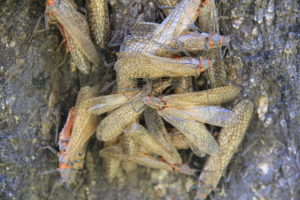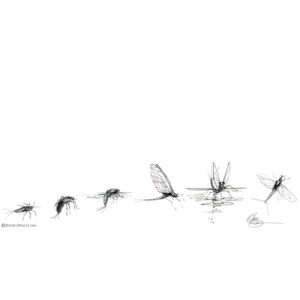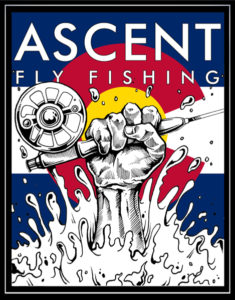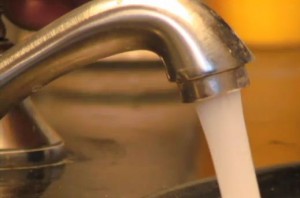Photo provided by Troutfin Studio at www.markajessop.com By: Peter Stitcher of Ascent Fly Fishing
Exhale... You've done it. You've successfully escaped the office. You've tunneled under the suburb's privacy fences, and the incessant drone cell phones and email notifications are fading into the distance behind you. In front of you lies a day without obligation and a river full of potential and the promise of hungry trout. Before you run down the trail and lose yourself on the water, slow down and PAUSE for a moment. Mother Nature has something to tell you, and listening will prove the difference between a day spent staring at the water or one punctuated with tight lines and wet hands as you release fish back into the river.
This message is a story about which bugs are hatching, what the trout are eating, and which fly patterns will give you the greatest chance of success on this water, on this day. The lines of this tale surround the river; it is recorded among the willows, whispered on the wind, and chiseled along the bed of the river. Guided by the acronym PAUSE, the fly fisher can interpret nature's cues, tie on the perfect combination of flies, and be ready for an epic day on the water.
 Parking lot to the River - Matching the hatch starts when you park the truck and continue on your way to the water's edge. While not the most appetizing script to read, plastered to your windshield and the grill of your car is a record of the bugs that were flying and hopping along the lake or river that you are planning to fish. The fragile wings of mayflies and sturdy grasshopper legs act like braille to the astute angler and are the first clues as to what flies they might fish that day. As you leave the parking lot and work your way down to the water, observe what is hopping and flying around you. Grasshoppers frantically leaping off the trail ahead of you, the wayward beetle landing on your shoulder, and the shrilling of the cicada, and caddis flies stirring into flight as you push through streamside trees are all indicators of food that might be falling or landing on the water.
Parking lot to the River - Matching the hatch starts when you park the truck and continue on your way to the water's edge. While not the most appetizing script to read, plastered to your windshield and the grill of your car is a record of the bugs that were flying and hopping along the lake or river that you are planning to fish. The fragile wings of mayflies and sturdy grasshopper legs act like braille to the astute angler and are the first clues as to what flies they might fish that day. As you leave the parking lot and work your way down to the water, observe what is hopping and flying around you. Grasshoppers frantically leaping off the trail ahead of you, the wayward beetle landing on your shoulder, and the shrilling of the cicada, and caddis flies stirring into flight as you push through streamside trees are all indicators of food that might be falling or landing on the water.
Above the Water- Swallows flying and swooping over the water are going to be your first indicator that bugs are hatching from the water and dry flies might be on the menu! As you reach the water's edge, watch for swarms of invertebrates over the water and streamside vegetation. Even at a distance, the chaotic flight of the caddis, the purposeful straightforward flight of the stonefly, and the orderly wave-like motion of the mayfly will be evident, and will help to direct you to the most likely dry flies in your fly box.
 Under the Water - It is beneath the surface of the water that trout do 75% of their feeding, and that's where the angler's most important information will be found. Using an Invertebrate Seine along the streambed and pulling rocks from the current to observe what is holding onto their surface will give you a detailed menu of which bugs are most abundant, as well as their size and color so that you can lay your fly box alongside and choose the closest match.
Under the Water - It is beneath the surface of the water that trout do 75% of their feeding, and that's where the angler's most important information will be found. Using an Invertebrate Seine along the streambed and pulling rocks from the current to observe what is holding onto their surface will give you a detailed menu of which bugs are most abundant, as well as their size and color so that you can lay your fly box alongside and choose the closest match.
Spider Webs - Spiders are Mother Nature's PhD level Entomologists and are the most efficient samplers of insects along the river. If it has been hatching or hopping along the water where you are fishing, the spiders will have caught them. Look for spider webs in the bushes and snags along the river and hold your fly box up to their latest catch to match the hatch.
Eddies - Like the Bermuda Triangle of Trout, swirling currents and backwaters along the edge of the river provide a catalog of the most active bugs in and on the water. Spinning on top of the rotating current will be a sample of spent invertebrate cases, crippled insects, and expired post-spawn adults. Beneath the surface of the water, the same currents that trapped the adults in their dizzying spin also act to deliver aquatic insects to these collection points where they can be easily observed and matched by the angler.
Success never comes easily for the fly fisherman. There is no such thing as a lucky fly that will produce every trip to the river, and there are no infallible guides equipped with crystal balls through which to foresee the next hatch. However, for the fly fisher who takes a moment to PAUSE and observe, the rewards will be immediate, the fish will be more frequent, and the experience on the water will be that much richer!

Peter Stitcher is an Aquatic Biologist and the Chief Fly Geek at Ascent Fly Fishing. At Ascent we don't guess what the fish are biting on, we know! With our Biologist Crafted Fly Selections you can tell us where you are fishing, when you are fishing, your budget, and skill level, and we will match down to the life cycle to the fly what the fish will be eating when you are on the water! You can see our full spread of flies and gear, and read our Sci-Fly Fishing Blog at: WWW.ASCENTFLYFISHING.COM
Ascent Fly Fishing is also a proud Trout Unlimited Business partner, and have provided free TU memberships to more than 1000 of our clients in the last two years.






 Recycle water:
Recycle water:
 “I carry two pair of gloves,” Doug told me. “I fish with a half-finger glove or foldover mit. Then I keep a pair of full-finger gloves in an inside pocket. If my hands get cold, I can pull out those warm gloves.”
“I carry two pair of gloves,” Doug told me. “I fish with a half-finger glove or foldover mit. Then I keep a pair of full-finger gloves in an inside pocket. If my hands get cold, I can pull out those warm gloves.”

